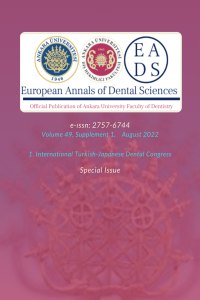Abstract
References
- Berkman ND, Davis TC, Mccormack L. Health literacy: What is it? Journal of health communication, 2010, 15: 9-19.
- Kohan S, Ghasemi S, Dodangeh M. Associations between maternal health literacy and prenatal care and pregnancy outcome. Iran. J. Nurs. Midwifery Res., 2008, 12: 146-152.
- Sabbahi DA, Lawrence HP, Limeback H, Rootman I. Development and evaluation of an oral health literacy instrument for adults. Community Dent. Oral Epidemiol., 2009, 37: 451-462.
- Parker EJ, Jamieson LM. Associations between indigenous australian oral health literacy and self-reported oral health outcomes. BMC Oral Health, 2010, 10: 1-3.
- Dickson-Swift V, Kenny A, Farmer J, Gussy M, Larkins S. Measuring oral health literacy: A scoping review of existing tools. BMC Oral Health, 2014, 14: 148.
- Peker K, Köse TE, Güray B, Uysal Ö, Erdem TL. Reliability and validity of the turkish version of the rapid estimate of adult literacy in dentistry (treald-30). Acta Odontol. Scand., 2017, 75: 198-207.
- Janicke DM, Finney JW, Riley AW. Children's health care use a prospective investigation of factors related to care-seeking. Med. Care, 2001: 990-1001.
- Hom JM, Lee JY, Divaris K, Baker AD, Vann Jr WF. Oral health literacy and knowledge among patients who are pregnant for the first time. The Journal of the American Dental Association, 2012, 143: 972-980.
- Khan K, Ruby B, Goldblatt RS, Schensul JJ, Reisine S. A pilot study to assess oral health literacy by comparing a word recognition and comprehension tool. BMC Oral Health, 2014, 14: 135-146.
- Vilella KD, Alves SGA, De Souza JF, Fraiz FC, Da Silva Assunçao LR. The association of oral health literacy and oral health knowledge with social determinants in pregnant brazilian women. J. Community Health, 2016, 41: 1027-1032.
Abstract
Aim
Oral health literacy is the capacity of individuals to receive and understand the health information and services necessary to make appropriate oral health decisions. Low oral health literacy is associated with insufficient oral health knowledge and behaviors. The aim of our study was to assess the level of oral health literacy of pregnant women and their ability to recognize words on the REALD-30 scale, as well as their knowledge of the meaning of words.
Methods
300 pregnant women between the ages of 18-45 who were admitted to the Obstetrics and Gynecology outpatient clinic of Ataturk University Faculty of Medicine participated in our study. The TREALD-30 scale, consisting of 30 words, determines the ability to read dental words. Participants received 1 point for each correctly read word in TREALD 30. A total of 0-30 points were scored. In addition, the word scores that participants knew the meaning of were evaluated under the heading TREALD-30-M. Analysis of the collected data was carried out in SPSS v26 program.
Results
The average age of the participants was 31.2 years and the average educational status was 13 years. It was found that 31% of participants had their first pregnancy. 66.7% of respondents were housewives and 9.7% were health workers. The number of words that can only be read was determined as 29, the number of those that can be read by knowing their meaning was 17, and the number of those that cannot be read was determined as 3 words. As the level of education increased, oral health literacy increased (p<0.001). Health workers showed higher TREALD-30 and TREALD-30-M scores compared to housewives (p<0.001).
Conclusion
In order to increase the level of oral health literacy of expectant mothers, health improvement programs are required.
Keywords
References
- Berkman ND, Davis TC, Mccormack L. Health literacy: What is it? Journal of health communication, 2010, 15: 9-19.
- Kohan S, Ghasemi S, Dodangeh M. Associations between maternal health literacy and prenatal care and pregnancy outcome. Iran. J. Nurs. Midwifery Res., 2008, 12: 146-152.
- Sabbahi DA, Lawrence HP, Limeback H, Rootman I. Development and evaluation of an oral health literacy instrument for adults. Community Dent. Oral Epidemiol., 2009, 37: 451-462.
- Parker EJ, Jamieson LM. Associations between indigenous australian oral health literacy and self-reported oral health outcomes. BMC Oral Health, 2010, 10: 1-3.
- Dickson-Swift V, Kenny A, Farmer J, Gussy M, Larkins S. Measuring oral health literacy: A scoping review of existing tools. BMC Oral Health, 2014, 14: 148.
- Peker K, Köse TE, Güray B, Uysal Ö, Erdem TL. Reliability and validity of the turkish version of the rapid estimate of adult literacy in dentistry (treald-30). Acta Odontol. Scand., 2017, 75: 198-207.
- Janicke DM, Finney JW, Riley AW. Children's health care use a prospective investigation of factors related to care-seeking. Med. Care, 2001: 990-1001.
- Hom JM, Lee JY, Divaris K, Baker AD, Vann Jr WF. Oral health literacy and knowledge among patients who are pregnant for the first time. The Journal of the American Dental Association, 2012, 143: 972-980.
- Khan K, Ruby B, Goldblatt RS, Schensul JJ, Reisine S. A pilot study to assess oral health literacy by comparing a word recognition and comprehension tool. BMC Oral Health, 2014, 14: 135-146.
- Vilella KD, Alves SGA, De Souza JF, Fraiz FC, Da Silva Assunçao LR. The association of oral health literacy and oral health knowledge with social determinants in pregnant brazilian women. J. Community Health, 2016, 41: 1027-1032.
Details
| Primary Language | English |
|---|---|
| Subjects | Dentistry |
| Journal Section | Conference Papers |
| Authors | |
| Publication Date | August 31, 2022 |
| Submission Date | July 1, 2021 |
| Published in Issue | Year 2022 Volume: 49 Issue: Suppl 1 |


